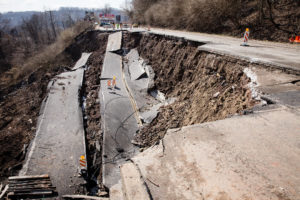GSI…. but why?
Background
Pittsburgh, Pennsylvania is a city defined in large part by water: from the 3 large rivers that help to outline the city’s center, to the snowfall that periodically graces this area’s winters, this element shapes human life in the region. Historically, the waterways running through the Pittsburgh area have been used for transportation (both of people and goods), sustenance (through farming and fishing), and recreation, among other pursuits. However, the influence of water in this region is not only benign: recently combined sewer overflows and landslides have arisen as challenges caused in large part by this force of nature.
But nature is not solely to blame. After all, a landslide in an undeveloped patch of forest causes next to no human inconvenience. Similarly, a combined sewer overflow [CSO] is a hazard that will never occur in an area lacking combined sewers. Clearly, humans have to share in some of the culpability for these concerns.

Accessed: 9/26/19

Accessed: 9/26/19
Potential Solutions
Thankfully, humans have already begun developing measures to address these issues. A suite of these methods, collectively known as Green Stormwater Infrastructure [GSI] (variously known as Low Impact Development [LID], Green Infrastructure [GI], Blue-Green Infrastructure [BGI], and Stormwater Best Management Practices [BMP], among others), has been developed to address problems in water management in urban and peri-urban settings.

Accessed: 9/26/19
GSI differs from traditional (or gray) stormwater infrastructure in several ways: most importantly, GSI attempts to intercept, collect, and infiltrate stormwater flows very close to their source (the area where the precipitation falls) as opposed to conveying the water toward a centralized treatment facility. By using this distributed, passive approach, GSI helps to reduce treatment costs by taking advantage of biological processes (e.g. plants taking up water from the soil and transpiring it to the atmosphere, or soil bacteria helping to break down pollutants) without the need for additional energy inputs.

Accessed: 9/26/19
But why are we discussing stormwater now, as we head into what is Pittsburgh’s driest month on average? Because unlike the one-trick pony that is gray infrastructure, GSI offers many other benefits to the community beyond stormwater management! A rain garden, for instance, not only serves to capture and treat a volume of stormwater related to its size, but can also be a beautiful focal point on a property. In addition to improving a site’s aesthetics (would you rather look at a manhole cover or a patch of wildflowers?) that same rain garden can provide habitat for pollinators and migratory birds, produce food for human consumption, filter particulate pollution from the air, and aid in groundwater recharge!

Accessed: 9/26/19
With so many community co-benefits to be gleaned from investments in GSI, it seems an obvious choice to incorporate it wherever possible into municipal stormwater management schemes. However, these installations are not without their costs. In order to update aging stormwater infrastructure to reduce sediment discharge into our waterways and eliminate CSOs, several municipalities (including Monroeville, Latrobe, and Mt. Lebanon) have begun implementing stormwater management fees.
Throughout Allegheny County, two main entities (Allegheny County Sanitary Authority [ALCOSAN] and Pittsburgh Water and Sewer Authority [PWSA]) control the majority of the conversation around water access, conveyance, and treatment. Each of them has worked toward integrating GSI into their infrastructure upgrades to varying degrees. PWSA has even made resources available so that residents can investigate their position in the larger water treatment plan.
The News
Very recently, ALCOSAN has negotiated a new plan, approved by the Environmental Protection Agency (EPA) to reduce the impacts of human development on natural water systems in the region. Unfortunately, the lion’s share of dollars allocated in this plan are for gray infrastructure upgrades, with a relatively small amount of investment in GSI.
What you can do!
If you’re interested in adjusting this outcome toward a greener, more human friendly approach, you’re in luck! We’re still within the public comment period when your voice can be heard: reach out to ALCOSAN, or the EPA to voice your concerns in the next month and your comment can make a difference.
If you’re still unsure, keep yourself informed about the issue by following the Our Water, Our Rivers Campaign on Facebook, or by attending public meetings where these issues are discussed. Whatever your choice, remember that you can make a difference in shaping the policies that guide development in our region.
Green water… rain gardens et al are a terrific and very sustainable idea. I am all for it!
Grey water I’d ok but where does it all go?
Green water is more cost effective and serves more than just one purpose.
More green water systems please.